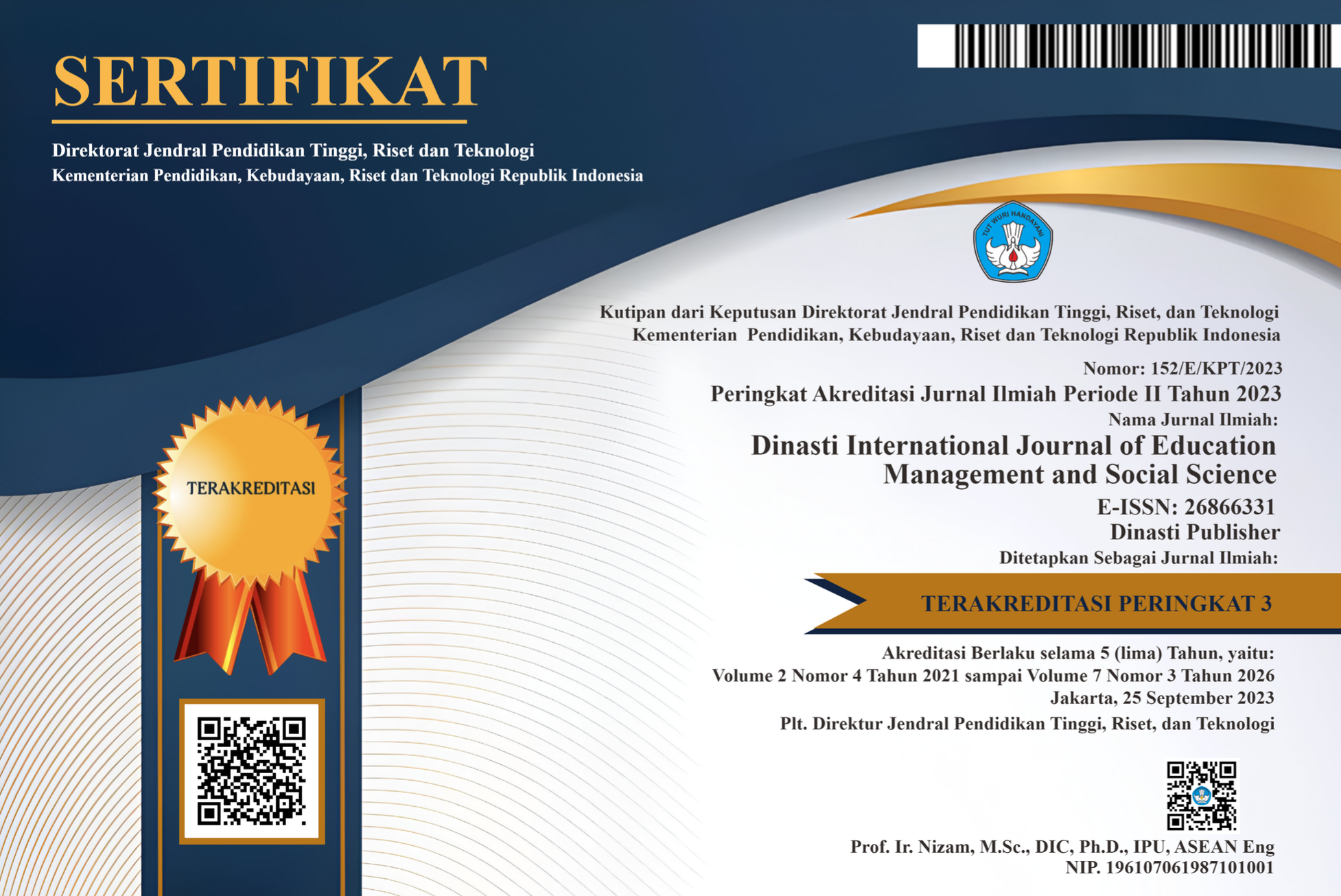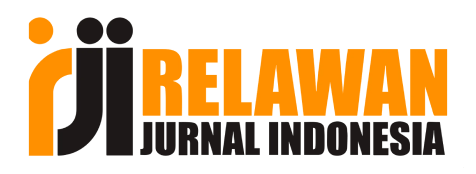Learning of Qur'an Memory in Realizing Qur'anic Resources in Sampit Kota Batam
DOI:
https://doi.org/10.38035/dijemss.v6i4.4432Keywords:
Qur'an Memorization, Learning Methods, Qur'anic ResourcesAbstract
This study examines the learning of Quran memorization in realizing Quranic resources at SMPIT Batam City. The purpose of this study was to determine the learning of Quran memorization, identify the challenges faced by teachers, describe the factors that influence learning, and determine the methods used in learning Quran memorization at SMPIT Batam City. The study was conducted in four schools: SMPIT Ulil Albab, SMPIT Fajar Ilahi Batu Aji, SMPIT Fajar Ilahi Sungai Beduk, and SMPIT El-Yasin. The research method used a qualitative approach with data collection techniques through observation and interviews. The results showed that the four schools implemented a tahfidz program with different characteristics. SMPIT Ulil Albab implemented the most structured program with five main methods (Talaqqi, Tikrar, Muraja'ah, Wahdah, and Jama') and the Munaqosyah evaluation system. SMPIT Fajar Ilahi (both branches) focused on the joint muroja'ah method and independent memorization with differentiation programs such as AOT (Acceleration of Tahfidz). SMPIT El-Yasin used a more flexible approach. The success rate of the program varied between 60-70%, with SMPIT El-Yasin recording the highest success rate. Spiritual impacts were consistently seen in all schools, including improvements in the quality of worship, prayer discipline, and improvements in student morals. The main challenges faced included limited learning time, a less than ideal teacher-student ratio, and limited learning media. In conclusion, despite variations in implementation and methodology, all four schools succeeded in achieving the main goal of forming a Qur'anic generation. Key success factors included a systematic approach, realistic targets, intensive guidance through the halaqoh system, and effective collaboration between teachers, students, and parents.
References
Abdussamad, H. Z., & Sik, M. S. (2021). Metode penelitian kualitatif. CV. Syakir Media Press.
Agustina, M., Yusro, N., & Bahri, S. (2020). Strategi peningkatan minat menghafal al-qur’an santri di pondok pesantren ar-rahmah curup. Didaktika: Jurnal Kependidikan, 14(1), 1–17.
Akbar, A., & Hidayatullah, H. (2016). Metode tahfidz al-qur’an di pondok pesantren kabupaten Kampar. Jurnal Ushuluddin, 24(1), 91–102.
Asril, Z., Munawir, K., & Taufan, M. (2024). Competency Challenges of Tahfizh Teachers in Indonesia: Systematic Literature Review.
Bungin, B. (2011). Penelitian Kualitatif. Prenada Media Group.
Creswell, J. W. (2015). Research Design?: Qualitative, Quantitative, And Mixed Methods Approaches (4th ed.). SAGE Publications Ltd.
Fatah, A. (2014). Dimensi keberhasilan pendidikan Islam program tahfidz al-Qur’an. Edukasia: Jurnal Penelitian Pendidikan Islam, 9(2).
Hidayah, N. (2016). Strategi pembelajaran tahfidz al-qur’an di lembaga pendidikan. Ta’allum: Jurnal Pendidikan Islam, 4(1), 63–81.
Kementrian Agama, R. I. (2012). Al-Qur’an Transliterasi per Kata dan Terjemah per kata. Bekasi: Cipta Bagus Segara.
Maskur, A. (2018). Pembelajaran Tahfidz Alquran pada Anak Usia Dini. IQ (Ilmu Al-Qur’an): Jurnal Pendidikan Islam, 1(02), 188–198.
Moleong, L. J. (2018). Metodologi Penelitian Kualitatif. PT Remaja Rosdakarya.
Nurhayati. (2022). ESENSI DAN SEBAB KESULITAN BERBAHASA ARAB SERTA PENANGANANNYA DALAM DUNIA PENDIDIKAN. JURNAL TA’LIMUNA, 1(1), 84–91.
Nurhayati, L. H., & Rosyadi, K. I. (n.d.). Determinasi Minat Belajar Dan Sikap Terhadap Prestasi Belajar Melalui Kreativitas Mahasiswa. Idea, 3, 1503.
Nurhayati, N., & Rosadi, K. I. (2022). DETERMINASI MANAJEMEN PENDIDIKAN ISLAM?: SISTEM PENDIDIKAN , PENGELOLAAN PENDIDIKAN , DAN TENAGA PENDIDIKAN ( LITERATUR MANAJEMEN PENDIDIKAN ISLAM ). 3(1), 451–464.
Oktavia, G., Nurfadhilah, N., & Febriani, A. (2024). Systematic Literature Review: Quran Memorization Methods in Indonesia.
Ramadhani, W., & Aprison, W. (2022). Urgensi pembelajaran tahfidz Al-Qur’an di era 4.0. Jurnal Pendidikan Tambusai, 6(2), 13163–13171.
Rasyid, D. (1998). Islam dalam berbagai dimensi. Gema Insani.
Sanjaya, W. (2010). Penilaian Hasil Proses Belajar Mengajar. Bandung: Remaja Rosda Karya.
Sugiyono. (2017a). Metode Penelitian Pendidikan Pendekatan Kuantitatif, Kualitatif dan R&D. Alfabeta.
Sugiyono, D. (2017b). Metode penelitian pendidikan pendekatan kuantitatif, kualitatif dan R&D.
Suhadak, I. (2018). Implementasi Metode Tahfidz Dalam Menghafalkan Al-Qur’an. Jurnal Perspektive, 11(1).
Suwaid, M. N. A. A. (2010). Prophetic parenting: cara Nabi Saw mendidik anak. (No Title).
Tahfidz, P. P., Smpit, D. I., Albab, U., Syarif, S., & Riau, K. (2023). Problematika pembelajaran tahfidz al-qur’an era pandemi covid 19 di smpit ulil albab batam.
Yunus, M. (1990). Kamus Arab-Indonesia (Jakarta: Hidakarya Agung) cet. III.
Downloads
Published
How to Cite
Issue
Section
License
Copyright (c) 2025 Nurhayati Nur, Ilyas Husti, Zamsiswaya Zamsiswaya

This work is licensed under a Creative Commons Attribution 4.0 International License.
Authors who publish their manuscripts in this journal agree to the following conditions:
- The copyright on each article belongs to the author(s).
- The author acknowledges that the Dinasti International Journal of Education Management and Social Science (DIJEMSS) has the right to be the first to publish with a Creative Commons Attribution 4.0 International license (Attribution 4.0 International (CC BY 4.0).
- Authors can submit articles separately, arrange for the non-exclusive distribution of manuscripts that have been published in this journal into other versions (e.g., sent to the author's institutional repository, publication into books, etc.), by acknowledging that the manuscript has been published for the first time in the Dinasti International Journal of Education Management and Social Science (DIJEMSS).















































